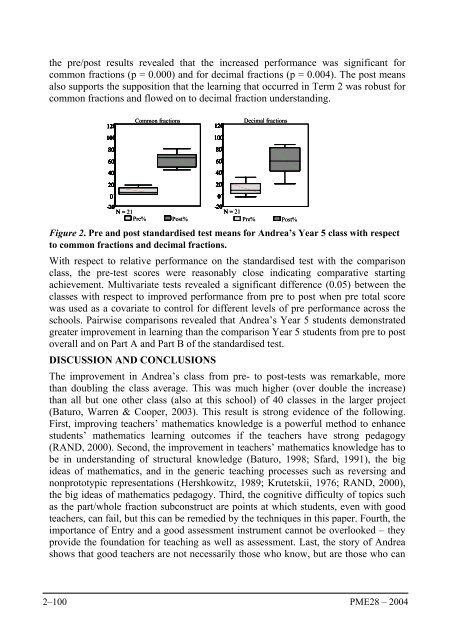empowering andrea to help year 5 students construct fraction ...
empowering andrea to help year 5 students construct fraction ...
empowering andrea to help year 5 students construct fraction ...
Create successful ePaper yourself
Turn your PDF publications into a flip-book with our unique Google optimized e-Paper software.
the pre/post results revealed that the increased performance was significant for<br />
common <strong>fraction</strong>s (p = 0.000) and for decimal <strong>fraction</strong>s (p = 0.004). The post means<br />
also supports the supposition that the learning that occurred in Term 2 was robust for<br />
common <strong>fraction</strong>s and flowed on <strong>to</strong> decimal <strong>fraction</strong> understanding.<br />
120<br />
100<br />
80<br />
60<br />
40<br />
20<br />
0<br />
-20<br />
N = 21<br />
Pre%<br />
Common <strong>fraction</strong>s<br />
Post%<br />
Decimal <strong>fraction</strong>s<br />
120<br />
100<br />
80<br />
60<br />
40<br />
20<br />
0<br />
-20<br />
N = 21<br />
Pre%<br />
Post%<br />
Figure 2. Pre and post standardised test means for Andrea’s Year 5 class with respect<br />
<strong>to</strong> common <strong>fraction</strong>s and decimal <strong>fraction</strong>s.<br />
With respect <strong>to</strong> relative performance on the standardised test with the comparison<br />
class, the pre-test scores were reasonably close indicating comparative starting<br />
achievement. Multivariate tests revealed a significant difference (0.05) between the<br />
classes with respect <strong>to</strong> improved performance from pre <strong>to</strong> post when pre <strong>to</strong>tal score<br />
was used as a covariate <strong>to</strong> control for different levels of pre performance across the<br />
schools. Pairwise comparisons revealed that Andrea’s Year 5 <strong>students</strong> demonstrated<br />
greater improvement in learning than the comparison Year 5 <strong>students</strong> from pre <strong>to</strong> post<br />
overall and on Part A and Part B of the standardised test.<br />
DISCUSSION AND CONCLUSIONS<br />
The improvement in Andrea’s class from pre- <strong>to</strong> post-tests was remarkable, more<br />
than doubling the class average. This was much higher (over double the increase)<br />
than all but one other class (also at this school) of 40 classes in the larger project<br />
(Baturo, Warren & Cooper, 2003). This result is strong evidence of the following.<br />
First, improving teachers’ mathematics knowledge is a powerful method <strong>to</strong> enhance<br />
<strong>students</strong>’ mathematics learning outcomes if the teachers have strong pedagogy<br />
(RAND, 2000). Second, the improvement in teachers’ mathematics knowledge has <strong>to</strong><br />
be in understanding of structural knowledge (Baturo, 1998; Sfard, 1991), the big<br />
ideas of mathematics, and in the generic teaching processes such as reversing and<br />
nonpro<strong>to</strong>typic representations (Hershkowitz, 1989; Krutetskii, 1976; RAND, 2000),<br />
the big ideas of mathematics pedagogy. Third, the cognitive difficulty of <strong>to</strong>pics such<br />
as the part/whole <strong>fraction</strong> sub<strong>construct</strong> are points at which <strong>students</strong>, even with good<br />
teachers, can fail, but this can be remedied by the techniques in this paper. Fourth, the<br />
importance of Entry and a good assessment instrument cannot be overlooked – they<br />
provide the foundation for teaching as well as assessment. Last, the s<strong>to</strong>ry of Andrea<br />
shows that good teachers are not necessarily those who know, but are those who can<br />
2–100 PME28 – 2004

















